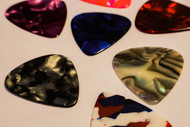Comparing Guitar Pick Materials
May 30th 2024

Comparing Guitar Pick Materials: Finding Your Ideal Pick
Of all the factors that go into choosing a guitar pick, material is often forgotten — but it’s as important as any other consideration. Just like guitar string material affects your instrument’s tone and playability, so too does pick material. It impacts brightness, volume, what picking techniques you can use and your ability to hold the pick.
Although we’ve discussed different guitar pick materials in other posts such as our tips for choosing an acoustic guitar pick, the topic is so big that we wanted to dig deeper. This guide to guitar pick materials will help you decide what material will help your guitar project the sound your ears are searching for.
A Quick History of Guitar Pick Materials
First, here’s a look at the history of the guitar plectrum. They have existed for centuries, being made from materials such as stone, wood and even feather quills. The first breakthrough came in 1885 when John Farris patented a pick made using the shell of the Atlantic Hawksbill Sea Turtle. Dubbed tortoise shell picks, they became widespread because of their superior tone, flexibility, durability, feel and string grab compared to other materials of the time.
However, in 1973, the U.S. added the Atlantic Hawksbill Sea Turtle to the endangered species list, banning their harvesting for any purpose — including guitar picks. As such, manufacturers were forced to turn to other materials. This may have been a blessing in disguise as there are now plenty of options to get the feel and tone you want. Let’s get into some of the guitar pick materials and the benefits of each.

Celluloid Guitar Picks
These plastic guitar picks were invented in 1922 by Luigi D’Andrea, the eventual founder of D’Andrea guitar accessories, using a tortoise-pattern celluloid sheet from a New York City sidewalk sale. Celluloid picks were already well-known by the 1970s but exploded in popularity following the tortoiseshell ban. They are known for having a balanced tone (though leaning towards bright), being flexible for strumming and being inexpensive. The main downside is that celluloid guitar picks tend to wear out and break more easily than other materials. Overall, though, they are a versatile option that adapts to most musical styles.
Nylon Guitar Picks
The nylon pick was invented by Herco (which Dunlop later purchased) in the early 1960s. Like celluloid, nylon picks became much more popular once tortoiseshell was out of the picture. The flex is comparable to celluloid, but nylon has a warmer sound and is more durable. As such, nylon is a good choice for mellow music such as folk, jazz and flamenco. The material is slick, though, which is why many manufacturers add bumps or holes to their picks to improve grip. It can also be blended with other materials like ceramic to add stiffness.
Acetal Guitar Picks
Though they go by several names, including Delrin, Tortex and Delrix, acetal picks all have the same basic design. Developed by guitar legend Jim Dunlop, acetal picks are made of a plastic that is much more rigid than celluloid or nylon. This gives them a bright-but-not-too-bright sound and lets you attack riffs and solos more aggressively. Acetal is also known to last a long time. On the other hand, acetal is slippery like nylon and won’t be as good for strumming.

Acrylic Guitar Picks
If you’re looking for the most rugged and brightest-sounding plastic picks around, try an acrylic guitar pick such as D'Addario Acrylux Picks. They wear so slowly that they’re a great material for a sharp-tipped pick, further adding to the brightness. Acrylic is by nature very thick and stiff — you can get acrylic picks up to 3mm thick. This is great for lead guitar but less than ideal for rhythm work. A final consideration is that acrylic lends itself well to colorful guitar picks that reflect your personality.
Ultem Guitar Picks
In recent years, Ultem have sprung up as an even more durable alternative to acetal. They feel stiff even in thinner gauges and glide across the strings like a hot knife through butter. The design lends itself well to shredding and other aggressive styles. However, precise technique is important because ultem guitar picks are more likely to generate string noise if you get sloppy.
Polycarbonate Guitar Picks
Do you want an ultra-strong pick that gives off a warmer sound and has more flex than similarly rugged materials? Polycarbonate picks (aka Lexan guitar picks) are the answer. They bend some for strumming but immediately return to their original form without becoming misshapen over time. The material is popular for jazz, folk and thumb picks. Polycarbonate is the same material used to make eyeglasses, so you know it’s tough.

Other Guitar Pick Materials
Although the six materials we’ve discussed are the most common, there are plenty of other options. Let’s quickly look at some of them.
- Carbon Fiber — A great choice if you want a super-strong pick that’s also super-thin for strumming.
- Wegen — A composite material commonly used for gypsy jazz because of its rigid durability.
- Metal — Picks made of steel or brass have perhaps the brightest tone but will be hard on your strings.
- Buffalo Horn — These picks have a tone and smoothness like classic tortoise shell picks but are known to splinter.
- Bone — A very hard and dense pick for lead guitar, though they have more string friction than other materials.
Whatever type of guitar pick you’re looking for, you can order them at Strings and Beyond. We carry guitar picks from all the leading brands, including Dunlop, Clayton, Fred Kelley, Pickboy, D’Addario, John Pearse and Fender. Once you’ve found the guitar pick material you like best, stock up with bulk discount pricing.

